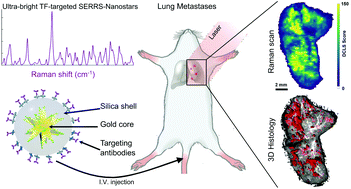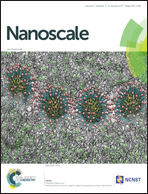Tissue factor-specific ultra-bright SERRS nanostars for Raman detection of pulmonary micrometastases†
Abstract
Here we demonstrate a novel application of ‘surface enhanced resonance Raman scattering nanoparticles’ (SERRS NPs) for imaging breast cancer lung metastases with much higher precision than currently feasible. A breast cancer lung metastasis mouse model was established by intravenous injection of LM2 cells. These mice were intravenously administered SERRS NPs conjugated with ALT-836, an anti-tissue factor (TF) monoclonal antibody, and subjected to Raman imaging to visualize the expression of TF both in vivo and ex vivo. Raman imaging indicated marked uptake of αTF-SERRS-NPs by the lung metastases compared to isotype and blocking controls. Conversely, little uptake of αTF-SERRS-NPs was observed in the lungs of healthy mice. Successful detection and delineation of pulmonary micrometastatic lesions as small as 200 μm, corroborated by histology, immunohistochemistry, and bioluminescence imaging confirmed the suitability of both TF as a target and αTF-SERRS-NPs as an effective contrast agent for imaging breast cancer lung metastases. Further advancements of this technique in the form of Raman endoscopes coupled with ultrabright SERRS NPs developed in this work could lead to minimally invasive detection and resection of lung metastases.


 Please wait while we load your content...
Please wait while we load your content...